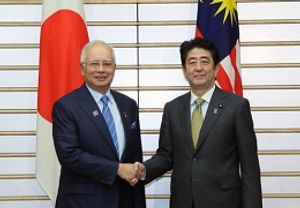On Monday, Malaysia and Japan signed a new strategic partnership to elevate their bilateral relationship during Malaysian prime minister Najib Razak’s three-day visit to Tokyo.
Malaysia and Japan already have a close relationship that goes back decades. As early as 1981, Malaysia’s fourth prime minister Mahathir Mohamad initiated the Look East Policy (LEP), which strengthened economic ties between the two nations. The relationship has since blossomed to include other areas of cooperation as well, such as maritime security, peacekeeping, and humanitarian assistance and disaster relief (HA/DR). Ties reached a stage of “enhanced partnership” in 2010 before being elevated to a “strategic partnership” this week.
Like most documents of its ilk, the Japan-Malaysia strategic partnership, an eight-page document seen by The Diplomat, consists of several parts outlining the areas of cooperation both sides have agreed to focus on. In this case, there are five sections dealing with peace and stability, economics, maritime security, people-to-people ties, and regional and global cooperation.
As has also been true of Japan’s relationship with a few other Southeast Asian states over the past few years, the headlines were on the advances in the security realm (See, for instance: “Japan and Indonesia: A New Maritime Forum?”). Most notably, Japan and Malaysia agreed to begin talks on transfers of defense equipment and technology. As Japan’s deputy chief cabinet secretary Katsunobu Kato pointed out, this makes Malaysia the first Southeast Asian country with which Tokyo has launched negotiations in this regard. The exact nature of that cooperation is still yet to be publicly disclosed, with the document only saying that the two countries had “decided to initiate negotiations on the framework for cooperation.” But Kato did mention that it would likely include areas such as disaster relief and maritime security.
The significant focus on maritime security in the document is also clear. That should come as no surprise: both sides have collaborated in this area before, and there have been growing concerns about Chinese behavior in both the East China Sea and the South China Sea (See: “Malaysia’s South China Sea Policy: Playing It Safe”). Maritime security is the only specific issue that gets its own section in the document – titled “Achieving Free, Open and Stable Sea” [sic] – alongside much more general fields like economics and peace and stability. The section suggests that Japan could increase capacity-building for Malaysia’s coast guard. Elsewhere in the document, the South China Sea issue is clearly addressed, with both sides emphasizing the importance of freedom of navigation and overflight, an early conclusion of a code of conduct, and the need for self-restraint in line with international law.
The economics section of the document mostly deals with strengthening the second phase of the Look East Policy, which Najib launched in 2013 – referred to as LEP 2.0. Malaysia and Japan agreed to expedite cooperation in areas including advanced industrial technologies, services, and managerial skills, and Abe said he would initiate a new cost-sharing training program under LEP 2.0. Another key area is infrastructure development, with the two sides agreeing to base their cooperation on what the Abe administration has been calling “quality infrastructure” (See: “Is This Japan’s New Challenge to China’s Infrastructure Bank?”). While a number of areas were mentioned, including power plants, water, and information and communication technology, the big-ticket item in the document was Japan’s interest in participating in building a high-speed railway project between Malaysia and Singapore.
Turning to people-to-people and cultural ties, the document begins by noting the existing infrastructure Malaysia and Japan have built thus far, including student exchange programs like JENESYS 2015 and the Malaysia-Japan International Institute for Technology, a hub of Japanese-style engineering education in ASEAN. One interesting development in this dimension is Japanese support for the establishment of a National Center for Disaster Management to serve as a regional hub for expertise, scholarship, and training in this field. This is in line with Malaysia’s focus on HA/DR more generally during its chairmanship of ASEAN this year (See: “ASEAN Eyes Closer Military Ties in 2015”).
Lastly, on the regional and global stage, both countries pledged to enhance cooperation through existing multilateral groupings such as the East Asia Summit, the ASEAN Regional Forum, and the United Nations. While this section in the document covered various areas of collaboration ranging from nuclear non-proliferation to reforming the United Nations, two focus areas stood out. The first is countering extremism, which is not a surprise considering the threat of the Islamic State to both countries (See: “Malaysia Says New Terror Group Trying to Create Islamic State”). The second was the humanitarian crisis involving the Rohingya. The document not only welcomed Malaysia’s efforts to provide humanitarian assistance for migrants, but also welcomed Japan’s intention to play its role in concert with the international community.

































